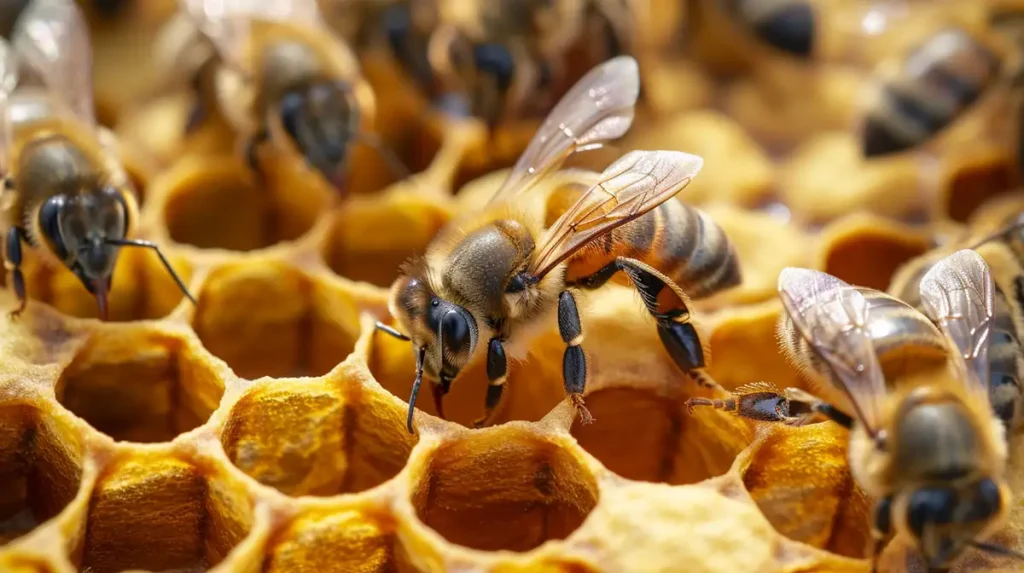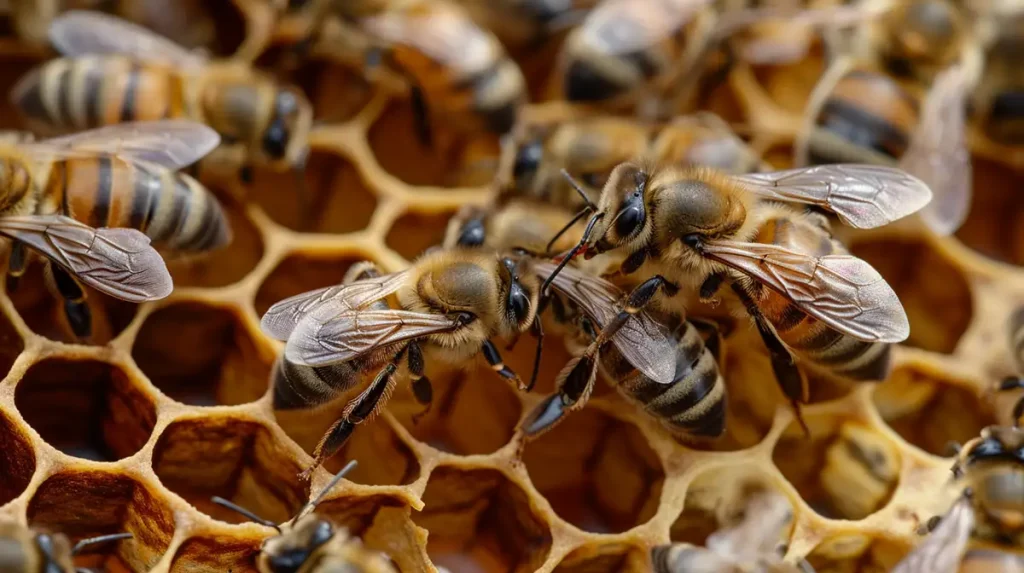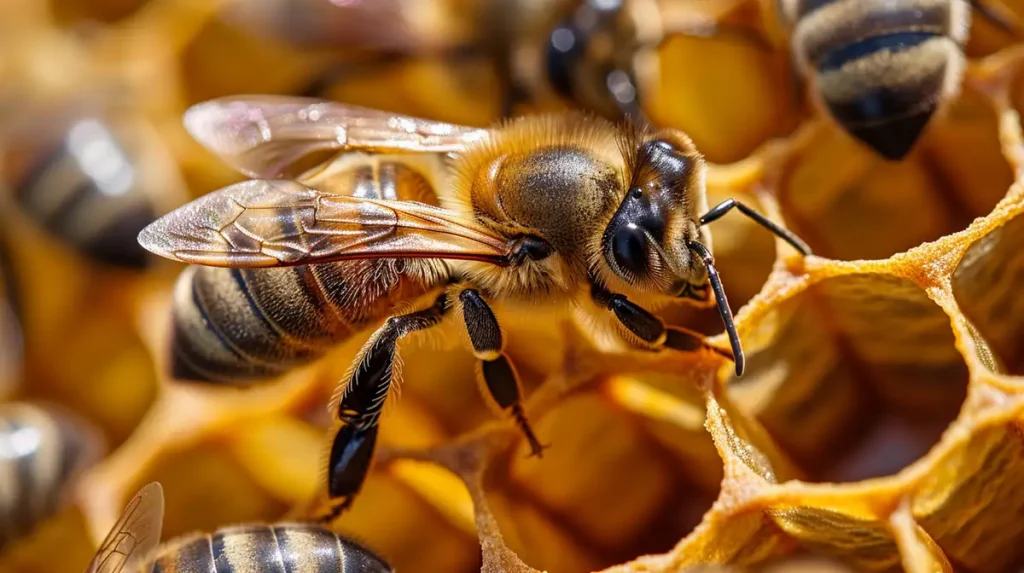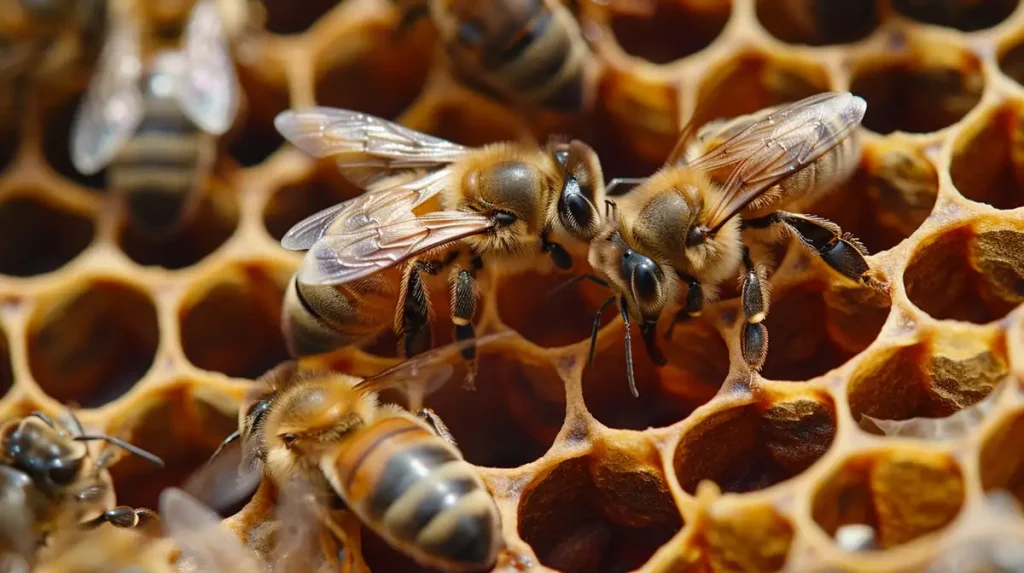Table of Contents
Queen bees typically live up to 3-4 years, but their lifespan is commonly less than a year due to factors like beekeeping practices. Their longevity is crucial for the colony’s survival, as they are the sole egg-layers. Aging queens with diminished pheromone production and reduced egg-laying ability may prompt the colony to raise a new queen.
In the below paragraphs, we will take a more detailed look at this topic.
When it comes to honeybees, the queen lives the longest out of all three castes (queen, drone, and worker). While the lifespan of the drones and workers varies from weeks to months depending on the time of year they hatch, the queen can live for a few years. On average, a honeybee queen will live for between three and four years, but studies have found some queens live for up to six or even eight years! How long the queen lives will typically be determined by how long she can continue laying eggs.
Key Takeaways
- Honeybee queen bees have a longer lifespan than worker bees and drones, living for an average of 3-4 years, and sometimes up to 6-8 years.
- Factors that influence a queen bee’s lifespan include genetics, nutrition, mating success, disease and parasites, and environmental factors.
- Worker bees have a shorter lifespan, usually living for 5-6 weeks during summer and 5-6 months during winter, due to constant activity, a less nutritious diet, and exposure to external threats.
- Human intervention can help extend a queen bee’s life through proper nutrition and care, requeening, and grafting, but beekeepers should focus on supporting the entire colony’s health and well-being.
- When a queen bee dies, worker bees initiate an “emergency queen rearing” process to replace the lost queen and restore the colony’s stability.
- Different types of queen bees have varying lifespans, such as honey bee queens (up to 5 years), bumblebee queens (1 year), and stingless bee queens (2-5 years).
Here is a detailed table outlining the factors that affect a queen bee’s lifespan:
| Factor | Description | Impact on Lifespan |
|---|---|---|
| Genetics | The genetic makeup of the queen bee plays a crucial role in determining her vitality, productivity, disease resistance, and ultimately, her lifespan. | Positive or negative, depending on the traits inherited. |
| Colony Size and Strength | A strong and populous colony can better support and protect the queen, affecting her health and longevity. | A larger, healthier colony typically supports a longer queen lifespan. |
| Disease and Parasites | Queens are susceptible to diseases and parasites, such as Nosema spp., Varroa mites, and viral infections, which can significantly shorten their lifespan. | Significantly negative, especially if not managed or treated. |
| Pheromone Production | The queen’s pheromones influence colony behavior and cohesion. Reduced pheromone production as the queen ages can lead to supersedure. | Decreased pheromone production can shorten a queen’s tenure by prompting the colony to raise a new queen. |
| Mating Success | Successful mating with multiple drones increases genetic diversity and the queen’s sperm reserve, affecting her egg-laying longevity. | Successful mating typically results in a longer productive lifespan. |
| Beekeeping Practices | Practices such as requeening, artificial insemination, and hive interventions can impact queen stress levels and health. | Can be either beneficial or detrimental, depending on how practices are implemented. |
| Nutrition | Adequate nutrition from a varied diet of pollen and nectar is crucial for queen health and longevity. | Poor nutrition can shorten lifespan, while good nutrition supports longer life. |
| Environmental Conditions | Environmental factors, including pesticide exposure, habitat destruction, and climate change, can stress the queen and colony. | Adverse environmental conditions can significantly reduce queen lifespan. |
| Queen Supersedure | The natural or beekeeper-induced replacement of an existing queen. This can occur due to aging, loss of productivity, or health issues. | Directly results in the end of the original queen’s reign, effectively shortening her lifespan within the hive. |
| Stress and Handling | Handling during queen rearing, transportation, and introduction to new colonies can stress the queen, affecting her health. | Excessive handling and stress can negatively impact lifespan. |
This table captures a range of biological, environmental, and management-related factors that influence the lifespan of queen bees, highlighting the complexity and interdependence of factors contributing to their health and longevity within the colony.
What Is The Queen Bee Lifespan?
The lifespan of a queen bee is quite impressive when compared to other members of the hive. While worker bees generally live for just a few weeks and drones (male bees) have a lifespan of around two months, a queen bee can live for several years. In fact, a healthy queen bee can live anywhere from 2 to 5 years, and sometimes even longer in certain conditions.
Factors Influencing a Queen Bee’s Lifespan
There are a few key factors that contribute to the longevity of a queen bee. These include:
1. Genetics
The genetic makeup of a queen bee plays a significant role in determining her lifespan. Some queen bees inherit genes that make them more resilient and better equipped to resist diseases, which can lead to a longer life.
2. Nutrition
Proper nutrition is essential for the health and longevity of a queen bee. Queen larvae are exclusively fed royal jelly, a nutrient-rich substance produced by worker bees. Once a queen bee emerges from her cell she will continue to be fed royal jelly throughout her life, which plays a key role in her overall health and longevity.
3. Mating Success
A queen bee’s ability to successfully mate with drones and store a sufficient amount of sperm for her entire reproductive life can also impact her lifespan. If a queen bee does not have enough stored sperm then she may need to be replaced by the beekeeper, which could shorten her life.
4. Disease and Parasites
A queen bee’s life can be significantly shortened if she is affected by diseases or parasites. Beekeepers must regularly monitor the health of their queen bees and take appropriate measures to prevent the spread of diseases and the infestation of parasites.
5. Environmental Factors
Finally, the overall environment in which a queen bee lives can have an impact on her lifespan. Factors such as temperature, humidity, and the availability of quality forage can all influence the health and longevity of a queen bee.

How Does A Queen Bee’s Lifespan Compare To Worker Bees?
One of the most intriguing aspects with bees is the differences in lifespans between the queen bee and her worker bee counterparts. The queen bee, as the name suggests, is the most crucial member of the colony and is responsible for laying eggs and producing new generations of bees. In contrast, worker bees play various roles in the hive, such as foraging for food, tending to the queen, and caring for the brood.
- Carter, Anthony (Author)
- English (Publication Language)
- 194 Pages - 02/28/2024 (Publication Date) - Independently published (Publisher)
Lifespan of Worker Bees
We have already discussed the actual lifespan of a queen bee in the above passages. Worker bees, on the other hand, have a much shorter lifespan, typically living between 5-6 weeks during the busy summer months and up to 5-6 months during the less active winter season. Their shorter lives can be attributed to their constant activity (which often causes their wings to wear out) and the fact that they consume a less nutritious diet of nectar and pollen. Additionally, worker bees are more exposed to external threats such as predators, disease, and harsh weather conditions as they forage for food and resources outside the hive.
What Factors Influence The Longevity Of Queen Bees?
We now know that queen bees are essential to the health and success of a honeybee colony as they are responsible for laying all the eggs and producing the pheromones that maintain the colony’s social structure. So while the longevity of a queen bee varies greatly and typically ranges from two to five years, it can be influenced by several factors. Understanding these factors can help you, as a beekeeper, ensure a long and healthy life for your colony’s queen.
Genetics
The genetic makeup of a queen bee can play a significant role in determining her overall lifespan. Some queen bees are genetically predisposed to live longer while others may have a shorter life expectancy. By selecting and breeding queen bees with desirable traits, beekeepers can help improve the lifespan of future generations of queens.
Nutrition and Health
Proper nutrition is vital for the queen bee’s longevity. The quality of the royal jelly can directly impact the queen’s health and lifespan. A well-nourished queen is more likely to have a stronger immune system, which can help her fend off diseases and parasites that could otherwise shorten her life.
Colony Stress
The overall stress experienced by the colony can also affect the queen bee’s lifespan. Factors such as overcrowding, disease, and exposure to pesticides can weaken the colony and increase stress levels. A stressed colony is more likely to replace its queen, even if she is still in good health. Maintaining a healthy environment for your colony can help alleviate stress and promote a longer life for your queen bee.
Mating Success
The success of a queen bee’s mating flights can impact her lifespan as well. A well-mated queen will have a larger sperm reserve, allowing her to lay eggs for a longer period. If a queen fails to mate with enough drones or encounters poor weather during her mating flights, she may run out of sperm earlier in her life and be replaced by the colony.
By understanding these factors and working to create a healthy environment for your honeybee colony, you can help ensure that your queen bee lives a long and productive life.

Can A Queen Bee’s Life Be Extended Through Human Intervention?
Yes, it is possible to extend a queen bee’s life through human intervention. Nevertheless, this process requires careful management and expertise in beekeeping. There are a few methods that can be employed to promote the longevity of a queen bee:
Proper Nutrition and Care
One way to support a queen bee’s health is by providing her with adequate nutrition and a well-maintained hive environment. As a beekeeper, you can ensure that the colony has access to a diverse and plentiful supply of nectar and pollen throughout the foraging season. This will help the queen maintain her strength and fertility. Additionally, keeping the hive clean and free of pests and diseases will contribute to the overall health of the queen and her colony.
Requeening
Another method to prolong the life of a queen bee is by periodically replacing her with a younger queen, a process known as requeening. Although this doesn’t directly extend the original queen’s life, it does help maintain the colony’s vitality and productivity. In this process, the old queen is removed and a new, young queen is introduced to the hive. The younger queen brings renewed vigor and a fresh genetic pool, which can improve the overall health and longevity of the colony.
Grafting
Grafting is a technique used in queen rearing where larvae are carefully transferred from worker cells to artificial queen cells. By selecting larvae from colonies with desirable traits such as disease resistance and longevity, beekeepers can produce queens with an increased potential for a longer life. Grafting can be labor-intensive and requires a high level of skill, but it allows for more control over the genetics of the resulting queen bees.
While human intervention can help extend a queen bee’s life to some extent, it’s important to remember that bees are wild creatures with their own natural cycles. The primary goal of a beekeeper should be to support and maintain the health and well-being of the entire colony, rather than focusing solely on the queen’s lifespan. By providing proper care, nutrition, and management, you can create an environment in which your queen bee and her colony can thrive.
What Happens When A Queen Bee Dies In The Colony?
When a queen bee dies in a colony, it creates a significant challenge for the hive as the queen is the only bee capable of laying fertilized eggs that will develop into worker bees and future queens. Without a queen, the colony’s population will eventually decline and the hive ultimately collapses. However, honeybees have evolved a remarkable process to address this issue and ensure their survival.
Emergency Queen Rearing
Upon the death of a queen bee, the worker bees immediately sense her absence due to the lack of queen pheromones in the hive. These pheromones help to maintain order and stability within the colony. In response, the worker bees will initiate a process known as “emergency queen rearing” to quickly replace the lost queen.
Selecting a Larva
The worker bees will select several young larvae, no older than three days, to be potential queen candidates. These larvae must be of the right age because their diet will need to be changed to exclusively consist of royal jelly. The consumption of royal jelly is crucial to the development of a queen bee as it helps her grow larger and become fertile.
Creating Queen Cells
Once the larvae have been selected, the worker bees will construct special wax cells around them known as “queen cells.” These cells are unique in shape and size, with a peanut-like appearance, and hang vertically in the hive. The chosen larvae will continue to be fed royal jelly throughout their development, allowing them to transform into fully-formed queen bees.
New Queen Emergence and Mating
After approximately 7-10 days, the new queens will emerge from their queen cells. However, a colony can only have one queen. As a result, the first queen to emerge will typically seek out and kill her rivals before they have a chance to hatch. Once she has secured her position, the new queen will leave the hive for a mating flight. During this flight, she will mate with multiple drones and store their sperm in her spermatheca. After successful mating, the queen will return to the hive and begin laying eggs, thus restoring the colony’s stability and ensuring its survival.

Are There Different Types Of Queen Bees With Different Lifespans?
Yes, there are indeed different types of queen bees with varying lifespans. The queen bee is the most important member of a bee colony as she is responsible for laying eggs and producing pheromones that maintain harmony within the hive. There are several bee species, and each has its own unique queen bee with specific characteristics and lifespan.
Honey Bee Queens
The most common type of queen bee is the honey bee queen, which is typically found in managed honey bee hives. A honey bee queen can live for up to 5 years, although their productivity often declines after 2-3 years. Beekeepers may replace the queen in a hive if her egg-laying capacity starts to diminish or if the colony’s health declines.
Bumblebee Queens
Bumblebee queens have a shorter lifespan than honey bee queens. They usually live for one year, as their life cycle is closely tied to the seasons. Bumblebee queens emerge from hibernation in the spring, establish a new colony, and lay eggs throughout the summer. Once the first generation of workers is born, the queen stays in the hive, laying eggs and being cared for by her offspring. When the season ends, the old queen, workers, and male bumblebees die, leaving only new-mated queens to hibernate and start the cycle anew the following spring.
Stingless Bee Queens
Stingless bee queens are another type of queen bee with varying lifespans. These bees are native to tropical and subtropical regions and are known for their complex social structures. The lifespan of a stingless bee queen can range from 2-5 years, depending on the species. As with honey bee queens, the productivity of stingless bee queens may decline with age, leading to a decline in the overall health of the colony.
How Long Do Queen Bees Live For – Conclusion
In conclusion, the lifespan of a queen bee is significantly longer than that of her drone and worker counterparts, ranging from 2-5 years on average, with some even reaching up to 7 years. Several factors, including genetics, nutrition, mating success, disease resistance, and environmental conditions contribute to the queen’s longevity. While human intervention can potentially extend the queen bee’s life, the primary focus should be on maintaining a healthy environment that fosters the well-being of the entire colony. Understanding the factors that influence queen bee longevity and the differences between various species of queen bees can help beekeepers and enthusiasts better appreciate the complex lives of these remarkable insects and ensure the continued success and survival of their colonies.
Looking to up your beekeeping game? Check out our latest product recommendations so you can take things to the next level!
Introducing The Top 12 Best Beekeeping Veils For 2024
Introducing The Top 20 Best Beekeeping Gloves For 2024
Introducing The Absolute Best Beekeeping Suits For 2024
The 15 Top Beekeeping Books for 2024
The Top 11 Honey Extractors for 2024
The Top 12 Mason Bee Houses for 2024
Beekeeping Disclaimer:
Beekeeping, like any agricultural activity, involves inherent risks. It is important to understand these risks and take appropriate measures to mitigate them.
Potential risks associated with beekeeping include:
- Bee stings: Honey bees are generally not aggressive but can become defensive if they feel threatened or their hive is disturbed. Bee stings can cause allergic reactions or even anaphylaxis in some individuals, which can be life-threatening. It is important to wear protective clothing and follow best practices when handling bees to minimize the risk of stings.
- Diseases and pests: Bees can be vulnerable to various diseases and pests, including mites, viruses, and bacterial infections. These can have significant impacts on bee colonies, leading to reduced honey production or even colony collapse. It is important to monitor hives regularly and take appropriate measures to prevent and treat diseases and pests.
- Weather conditions: Extreme weather conditions, such as drought or cold temperatures, can affect the health and productivity of bee colonies. It is important to ensure that hives are appropriately sheltered and provided with adequate food and water.
- Environmental hazards: Bees can be affected by environmental hazards such as pesticide exposure, pollution, and habitat loss. It is important to be aware of these hazards and take appropriate measures to protect bee colonies and promote healthy environments for bees.
- Legal requirements: Beekeeping may be subject to local, state, or national regulations, such as registration or inspection requirements. It is important to be aware of these requirements and comply with them.
While beekeeping can be a rewarding and enjoyable activity, it is important to be aware of the potential risks and take appropriate measures to mitigate them. By following best practices and staying informed about the latest developments in beekeeping, beekeepers can help ensure the health and productivity of their hives and contribute to the well-being of bee populations worldwide.
Last update on 2024-04-23 / Affiliate links / Images from Amazon Product Advertising API


